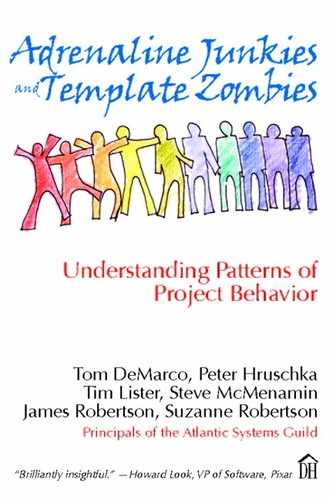9. Management By Mood Ring1
,1 Mood rings became popular in the U.S. during the 1970s. The idea behind the mood ring was simple: You wore it on your finger, and the color of the stone reflected the state of your emotions. For a few dollars, you could figure out how you were feeling.

“Mood Ring” by Bruce MacEvoy
The manager reports status based on the activities, efforts, and enthusiasms of the team rather than on the risks, decisions, and issues facing the project.
Listen to project managers talk about their work. Listen especially to how they communicate the status of their projects. It often reveals quite a bit about how they manage.
Following is a status summary from a manager we’ll call Donna. Although this example is extreme, it is representative of many real reports:
“I am delighted to report that we are just about Feature Complete for this release. There are a couple of stragglers, but I am just so proud of how much the team has accomplished and how hard everyone has been working to get to where we are. And judging by the big smiles I see around the office, morale remains high. I am grateful to have such high-performing team members, and I just know they will get the few remaining features finished any day now.
“On a sadder note, I am sorry to have to report that Bob Jensen has decided to leave the company. Bob has been a mainstay of our QA team for over five years now, and he will be missed. Bob’s departure follows the retirement of Kathy Enright just last month. As you know, Kathy was also a very experienced tester, so you can bet that our QA manager is starting to sweat bullets.
“I, too, am a little worried about the state of test development for the new features. It’s too soon to jump to any conclusions, so just let me say that I’m feeling a little uncomfortable. While I am sad to see great coworkers and good friends like Kathy and Bob ride off into the sunset, our QA team is famous for stepping up in tough times, and I know it’ll be burning the midnight oil. We should know more as time goes on.”
Notice some things about how Donna described the state of the work:
1. She spoke in terms of the high level of activity, her team’s earnest effort, and everyone’s enthusiasm for the project.
2. She focused on the present, plus or minus a little bit, without reference to the overall framework of time, resources, and deliverables within which her team is operating.
3. When she identified things that were not going according to plan, she spoke of them in terms of the emotions they evoked (for example, “I, too, am a little worried about the state of test development. . . .”).
4. Her observations are generally open-ended and
continuous (for example, “I just know they will get the few remaining features finished any day now.”).
5. Despite the occasional negative note, the overall tone of the report is optimistic.
You may be asking, What’s so bad about managers being optimistic and displaying a little emotion? Nothing, of course. But when you find a project manager whose communication is skewed very strongly to this end of the spectrum, you will typically discover two problems. First, this style of reporting does not really fulfill the most fundamental purpose of all project status reporting: It does not focus our attention on the elements of the effort that are in greatest need of immediate corrective action in order to maximize the probability of success. It doesn’t tell us what current conditions need our attention, decisions, and action on this project over the next few weeks. Because of the way Donna described things, all we have is a qualitative assessment of a few aspects of the work, with no clear sense of the relative magnitude of any of the issues.
The second condition that frequently accompanies this kind of communication is even more pernicious: Project managers who focus exclusively on open-ended, present-tense activities often do not have a clear sense of the ultimate outcomes they are trying to achieve. They—and their teams—are simply putting one foot in front of the other, as quickly as possible. Yet these teams are most likely to discover only at the last minute that they have no hope of shipping on time, or that they have drifted so far off-course that what they can deliver is not what was promised.
We spoke earlier about Donna’s communication style being at one end of a spectrum. Let’s hear from Lisa, a manager at the other end of that spectrum:
“We hit our Feature Complete date last week, on the twenty-eighth of April. Of the eighteen components that make up this release, fifteen of them are now Feature Complete; two more will be complete by the end of this week. The final component, the Data Warehouse Interface, is running even later; we don’t expect it to reach Feature Complete until May twentieth. QA is presently assessing what level of re-prioritization would be needed to absorb this slippage, or whether this may cause us to propose moving the ship date. QA will have a recommendation for our next core team meeting on May tenth. In any case, Product Management has agreed that we can do the public beta next month without this feature.
“The automated regression suite for existing features is complete as of this week, and we are now running it nightly. Pass rates are in the eighty-percent range, which is typical for this time in the release cycle. We expect to see pass rates in the ninety-percent range within four weeks, in time for the delivery of the public beta.
“Development of new feature tests has been slowed by the resignations of two QA engineers over the past thirty days. Recruitment of replacements is under way, but we have to assume that they will not be onboard and effective in time to help us with this release. QA is assessing the possibility of borrowing a couple of people from the support team to help out. We should know how this loss will affect test coverage of the new features within a week, but for now, we have to assume that we will not hit the Test Development Complete milestone on schedule.”
Lisa’s status summary is different from Donna’s in several ways:
1. She bases her assessment on the status of deliverables that are appropriate to the nature of the work now going on.
2. She focuses on outages, issues, and proposed changes to plan, and she identifies the required corrective actions and decisions.
3. Her observations are discrete, not continuous, and most are measurable.
4. She offers a balance of objective and judgmental information.
Very few managers communicate exactly like Donna or Lisa. Most of us are somewhere in between. Nevertheless, it is worth watching out for the Donnas. A pattern of consistently focusing on effort over progress sometimes reveals a manager who does not comprehend the difference between steering and navigating.
Oh, and by the way, it’s especially important to look for Donna in the mirror. If you find your own communication veering that way, ask yourself whether you might be doing so because, like Donna, you are not all that sure where your team should be going, just that everyone is working really hard to get there.
